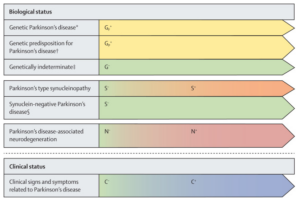
With the hope that disease-modifying treatments could target the molecular basis of Parkinson’s disease, even before the onset of symptoms, we propose a biologically based classification. Our classification acknowledges the complexity and heterogeneity of the disease by use of a three-component system (SynNeurGe): presence or absence of pathological α-synuclein (S) in tissues or CSF; evidence of underlying neurodegeneration (N) defined by neuroimaging procedures; and documentation of pathogenic gene variants (G) that cause or strongly predispose to Parkinson’s disease. These three components are linked to a clinical component (C), defined either by a single high-specificity clinical feature or by multiple lower-specificity clinical features. The use of a biological classification will enable advances in both basic and clinical research, and move the field closer to the precision medicine required to develop disease-modifying therapies. We emphasise the initial application of these criteria exclusively for research. We acknowledge its ethical implications, its limitations, and the need for prospective validation in future studies.

